service indicator CHEVROLET MONTE CARLO 1996 5.G Owners Manual
[x] Cancel search | Manufacturer: CHEVROLET, Model Year: 1996, Model line: MONTE CARLO, Model: CHEVROLET MONTE CARLO 1996 5.GPages: 340, PDF Size: 17.79 MB
Page 68 of 340
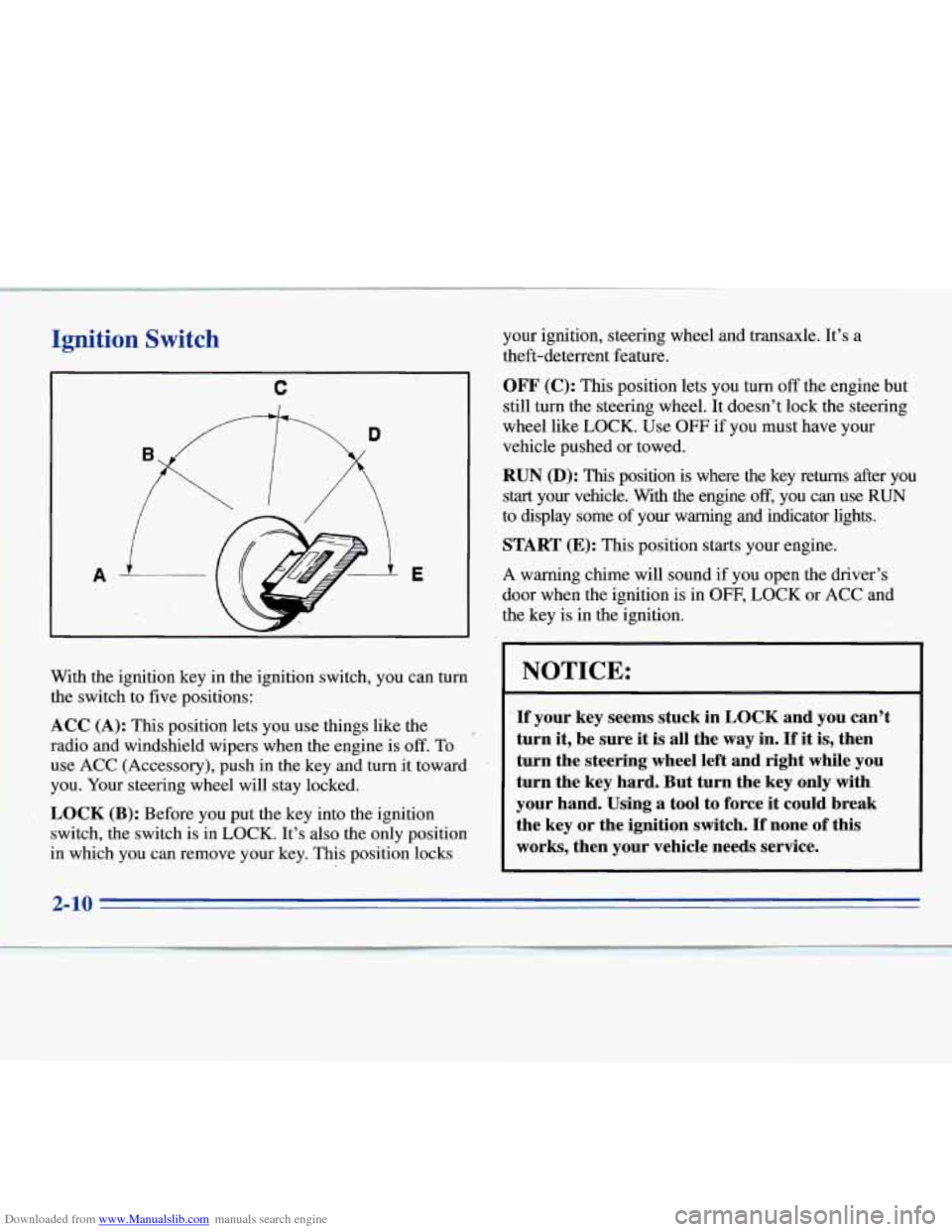
Downloaded from www.Manualslib.com manuals search engine Ignition Switch
C
With the ignition key in the ignition switch, you can turn
the switch to
five positions:
ACC (A): This position lets you use things like the
radio and windshield wipers when the engine is off. To
use ACC (Accessory), push in the key and turn it toward
you. Your steering wheel will stay locked.
LOCK-(B): Before you put the key into the ignition
switch, the switch is in LOCK. It’s also the only position
in which you can remove your key. This position locks your
ignition, steering wheel and transaxle. It’s a
theft-deterrent feature.
OF” (C): This position lets you turn off the engine but
still turn the steering .wheel. It doesn’t lock the steering
wheel like LOCK. Use
OFF if you must have your
vehicle pushed
or towed.
RUN (D): This position is where the key returns after you
start your vehicle. With the engine off, you can use RUN
to display some of your warning and indicator lights.
START (E): This position starts your engine.
A warning chime will sound if you open the driver’s
door when the ignition is in
OFF, LOCK or ACC and
the key is in the ignition.
NOTICE:
If your key seems stuck in LOCK and you can’t
turn
it, be sure it is all the way in. If it is, then
turn the steering wheel left and right while you
turn the key hard. But turn the key only with
your hand. Using
a tool to force it could break
the key or the ignition switch. If none
of this
works, then your vehicle needs service.
2-10
Page 106 of 340
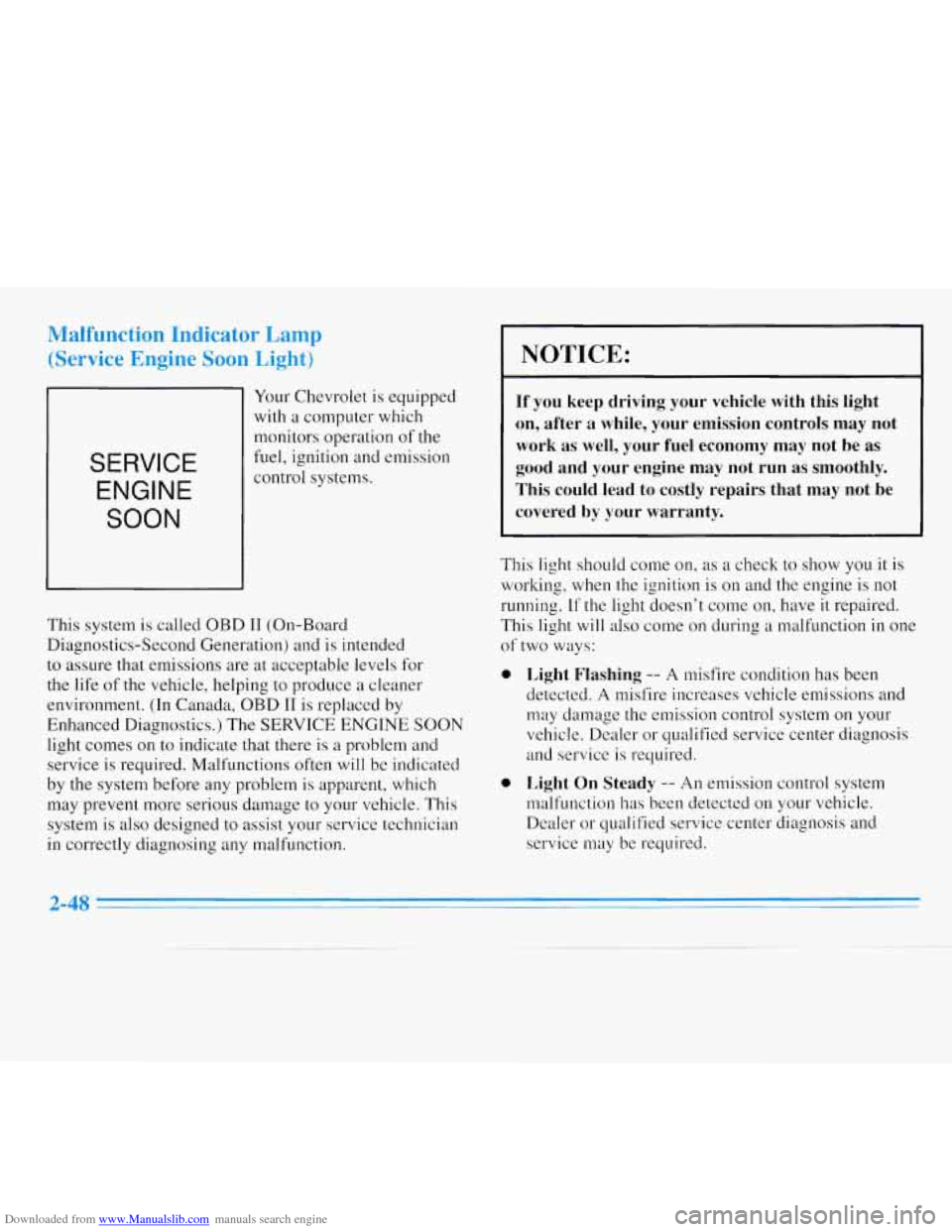
Downloaded from www.Manualslib.com manuals search engine Malfunction Indicator Lamp
(Service Engine Soon Light)
I
SERVICE
ENGINE
SOON
Your Chevrolet is equipped
with
a computer which
monitors operation
of the
fuel, ignition and emission
control systems.
This system is called OBD I1 (On-Board
Diagnostics-Second Generation) and is intended
to assure that emissions are at acceptable levels .for
the
life of the vehicle, helping to produce a cleaner
environment. (In Canada, OBD
I1 is replaced by
Enhanced Diagnostics.) The
SERVICE ENGINE SOON
light comes on to indicate that there is a problem and
service is required. Malfunctions often
will be indicated
by
the system before any problem is apparent, which
may prevent more serious damage to your vehicle. This
system is also designed to assist your service technician
in correctly diagnosing any malfunction.
0
0
NOTICE:
If you keep driving your vehicle with this light
on, after a while, your emission controls may not
work as well, your fuel economy may not
be as
good and your engine may not run as smoothly.
This could lead to costly repairs that may not be
covered by your warranty.
This light should come on, as a check to show you it is
working, when the ignition
is on and the engine is not
running.
If the light doesn’t come on, have it repaired.
This light
will also come on during a malfunction in one
of two ways:
Light Flashing -- A misfire condition has been
detected.
A misfire increases vehicle emissions and
may damage the emission control system on your
vehicle. Dealer or qualified service center diagnosis
and service is required.
Light On Steady -- An emission control system
malfunction
has been detected on your vehicle.
Dealer or qualified service center diagnosis and
service may be required.
2-48
Page 110 of 340
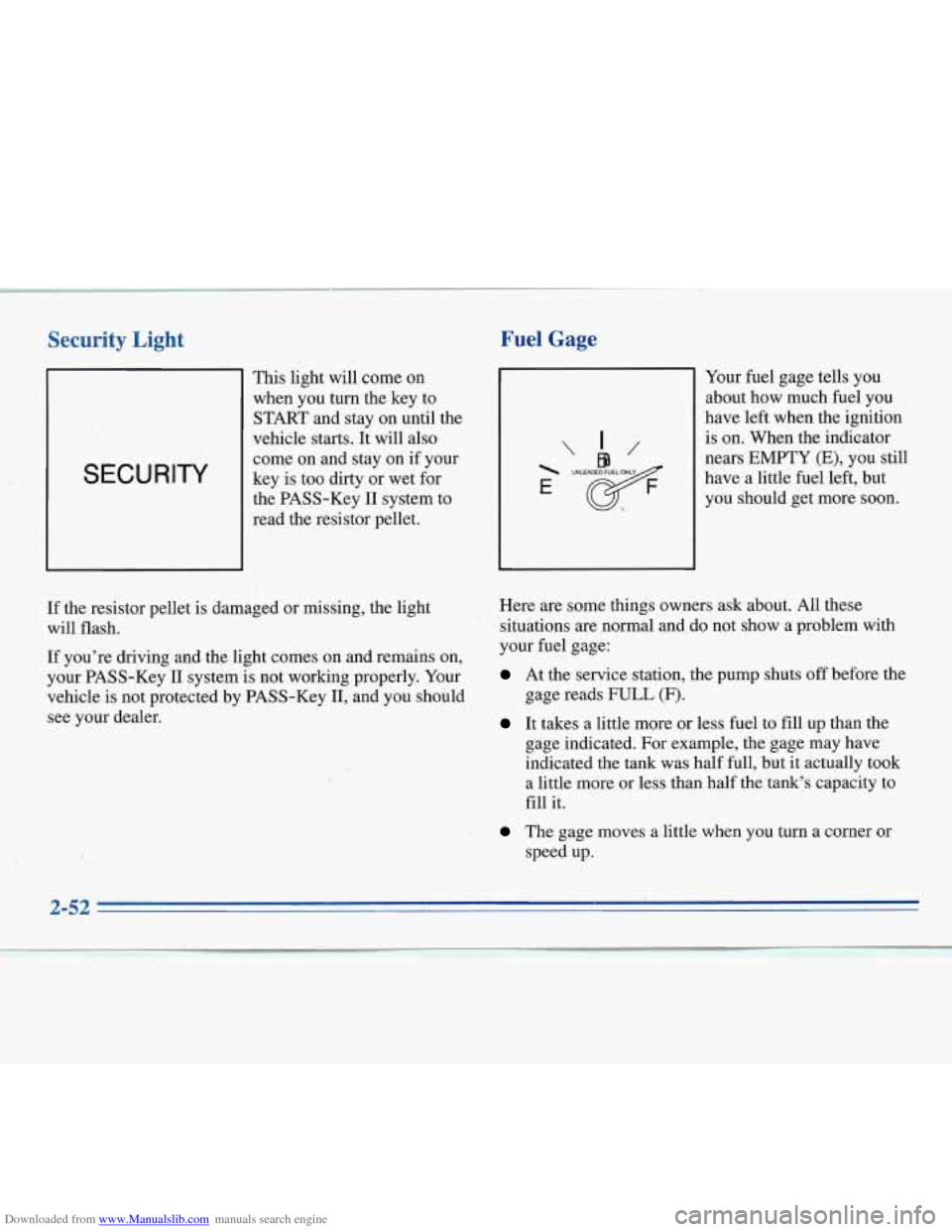
Downloaded from www.Manualslib.com manuals search engine Security Light
SECURITY
This light will come on
when you turn the key to
START and stay on until the
vehicle starts. It will also
come on and stay on if your
key is too dirty or wet for
the PASS-Key
I1 system to
read the resistor pellet.
Fuel Gage
"/@9 I/
E
If the resistor pellet is damaged or missing, the light
will flash.
If you're driving and the light comes on and remains on,
your PASS-Key
I1 system is not working properly. Your
vehicle is not protected by PASS-Key
11, and you should
see your dealer. Here are some
things owners ask about. All these
situations are normal and do not show a problem with
your fuel gage:
At the service station, the pump shuts off before the
gage reads
FULL (F).
It takes a little more or less fuel to fill up than the
gage indicated. For example, the gage may have
indicated the tank was half full, but it actually took
a little more or less than half the tank's capacity to
fill it.
The gage moves a little when you turn a corner or
speed up. Your
fuel gage tells you
about how much fuel you
have left when the ignition
is on. When the indicator
nears EMPTY (E), you still
have a little fuel left, but
you should get more soon.
2-52 7. I
....
Page 210 of 340
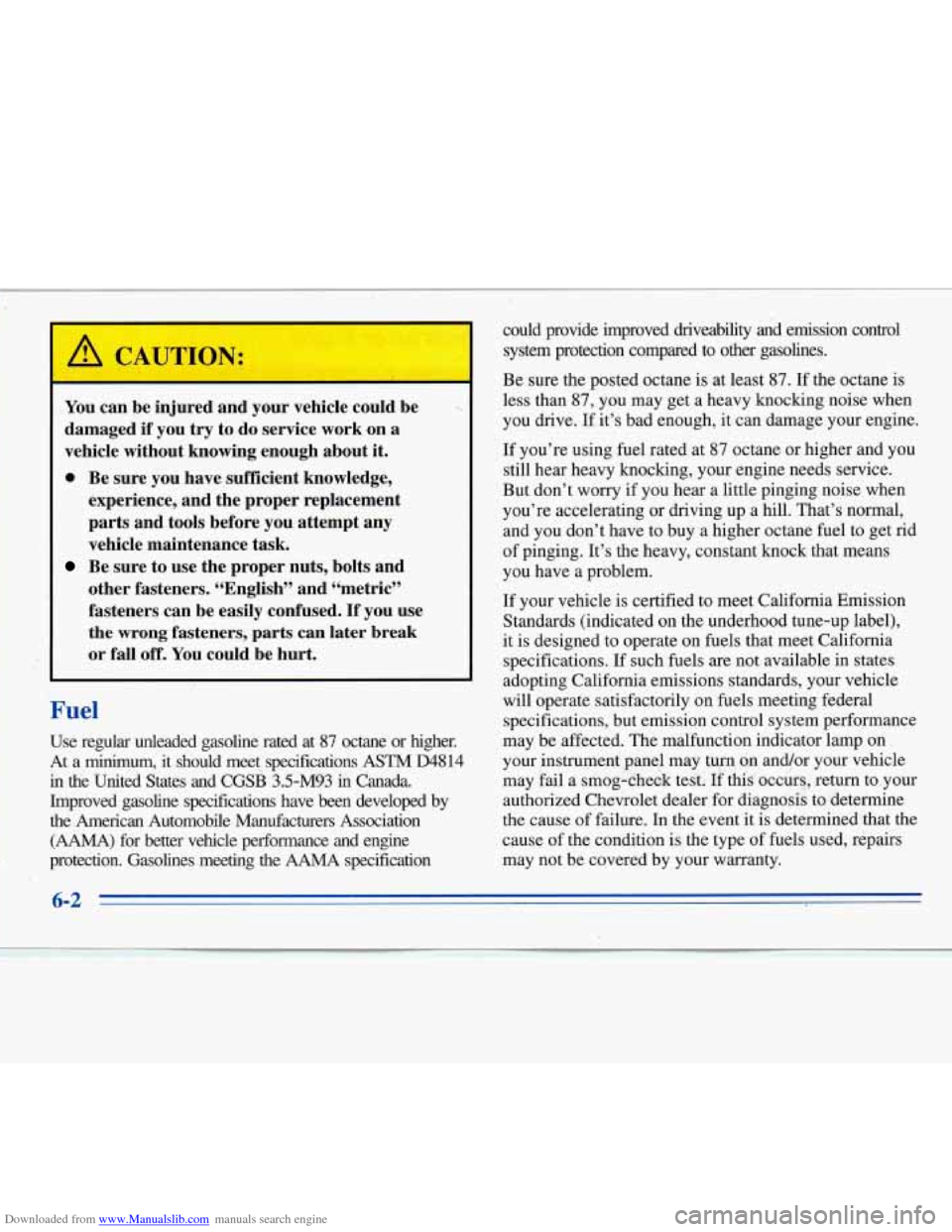
Downloaded from www.Manualslib.com manuals search engine You can be injured and your vehicle could be
damaged if you try to do service work on a
vehicle without knowing enough about it.
0 Be sure you have sufficient knowledge,
experience, and the proper replacement
parts and tools before you attempt any
vehicle maintenance task.
Be sure to use the proper nuts, bolts and
other fasteners. “English” and “metric”
fasteners can be easily confused. If you use
the
wrong fasteners, parts can later break
or fall off. You could be hurt.
Fuel
Use regular unleaded gasoline rated at 87 octane or higher.
At a.minimum, it should meet specificatiom.ASTM D4814
in the United States and
CGSB 3.5-M93 in Canada.
Improved gasoline specifications have been developed by
the American Automobile Manufacturers Association
(AAMA) for better vehicle performance and engine
protection. Gasolines meting
the AAMA specification
~~~ ~ ~~~
could provide improved driveability and emission control
system protection compared
to other gasolines.
Be sure the posted octane is at least 87. If the octane is
less than 87, you may get a heavy knocking noise when
you drive. If it’s bad enough, it can damage your engine.
If you’re using fuel rated at 87 octane or higher and you
still hear heavy knocking, your engine needs service.
But don’t worry if you hear a little pinging noise when
you’re accelerating or driving up a hill. That’s normal,
and you don’t have to buy a higher octane fuel to get rid
of pinging. It’s the heavy, constant knock that means
you have a problem.
If your vehicle is certified to meet California Emission
Standards (indicated on the underhood tune-up label),
it is designed to operate on fuels that meet California
specifications. If such fuels are not available in states
adopting California emissions standards, your vehicle
will operate satisfactorily on fuels meeting federal
specifications, but emission control system performance
may be affected. The malfunction indicator lamp on
your instrument panel may turn on and/or your vehicle
may fail a smog-check test.
If this occurs, return to your
authorized Chevrolet dealer for diagnosis to determine
the cause of failure. In the event it is determined that the
cause
of the condition is the type of fuels used, repairs
may not be covered by your warranty.
6-2
Page 211 of 340
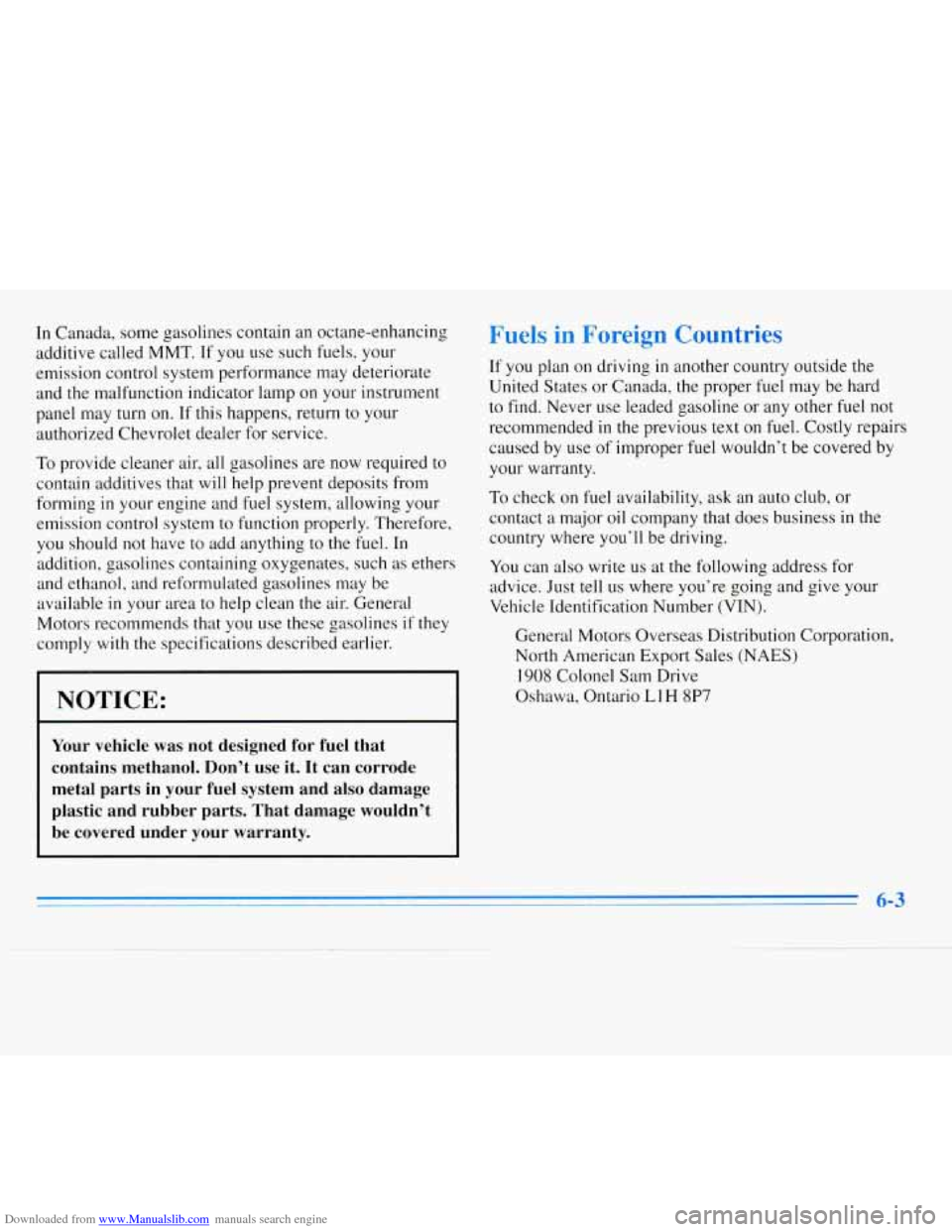
Downloaded from www.Manualslib.com manuals search engine In Canada, some gasolines contain an octane-enhancing
additive called
MMT. If you use such fuels, your
emission control system performance may deteriorate
and the malfunction indicator lamp on your instrument
panel may turn on. If this happens, return to your
authorized Chevrolet dealer for service.
To provide cleaner air, all gasolines are now required to
contain additives that will help prevent deposits from
forming
in your engine and fuel system, allowing your
emission control system to function properly. Therefore,
you should not have to add anything to the fuel. In
addition, gasolines containing oxygenates, such
as ethers
and ethanol, and reformulated gasolines may be
available in your area to help clean the air. General
Motors recommends that you use these gasolines if they
comply
with the specifications described earlier.
NOTICE:
Your vehicle was not designed for fuel that
contains methanol. Don’t use it. It can corrode
metal parts in your fuel system and also damage
plastic and rubber parts. That damage wouldn’t be covered under your warranty.
Fuels in Foreign ‘loun
If you plan on driving in another country outside the
United States or Canada, the proper fuel may be hard
to find. Never use leaded gasoline or any other fuel not
recommended in the previous text on fuel. Costly repairs
caused by use of improper fuel wouldn’t be covered by
your warranty.
To check on fuel availability, ask an auto club, or
contact a major oil company that does business in the
country where you’ll be driving.
You can also write us at the following address for
advice. Just tell us where you’re going and give your
Vehicle Identification Number (VIN).
General Motors Overseas Distribution Corporation,
North American Export Sales (NAES)
1908 Colonel Sam Drive
Oshawa, Ontario LlH
8P7
6-3
Page 235 of 340
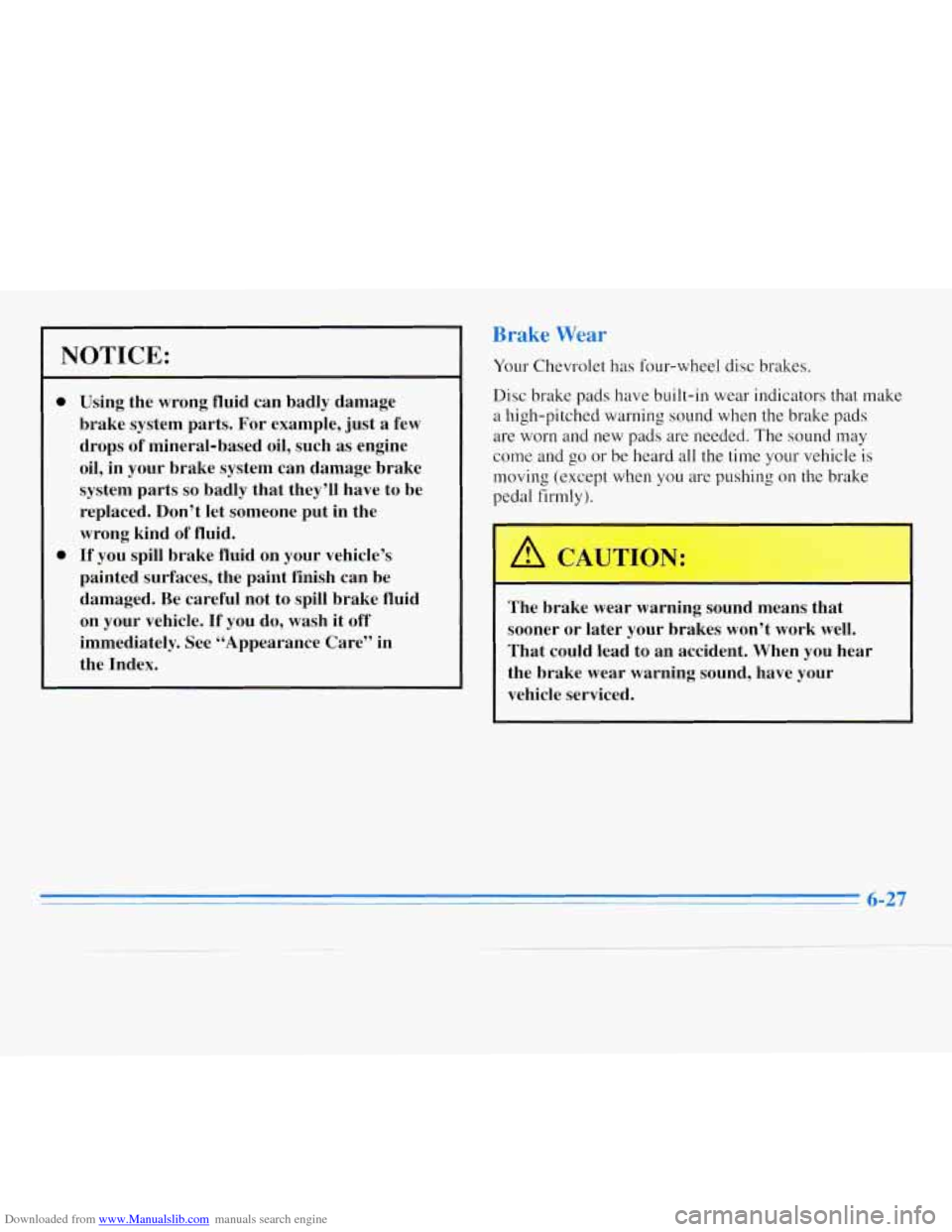
Downloaded from www.Manualslib.com manuals search engine Brake Wear
NOTICE:
0
0
Using the wrong fluid can badly damage
brake system parts. For example, just
a few
drops
of mineral-based oil, such as engine
oil, in your brake system can damage brake
system parts
so badly that they’ll have to be
replaced. Don’t let sonleone put in the
wrong kind of fluid.
If you spill brake fluid on your vehicle’s
painted surfaces, the paint finish can be
damaged. Be careful not to spill brake fluid
on your vehicle.
If you do, wash it off
immediately. See “Appearance Care” in
the Index.
Your Chevrolet has four-wheel disc brakes.
Disc brake pads have built-in wear indicators
that make
a high-pitched warning sound when
the brake pads
are worn and new pads are needed. The sound may
come and
go or be heard all the time your vehicle is
moving (except when
you are pushing on the brake
pedal firmly).
The brake wear warning sound means that
sooner or later your brakes won’t work well.
That could lead to an accident. When you hear
the brake wear warning sound, have your
vehicle serviced.
6-27
Page 334 of 340
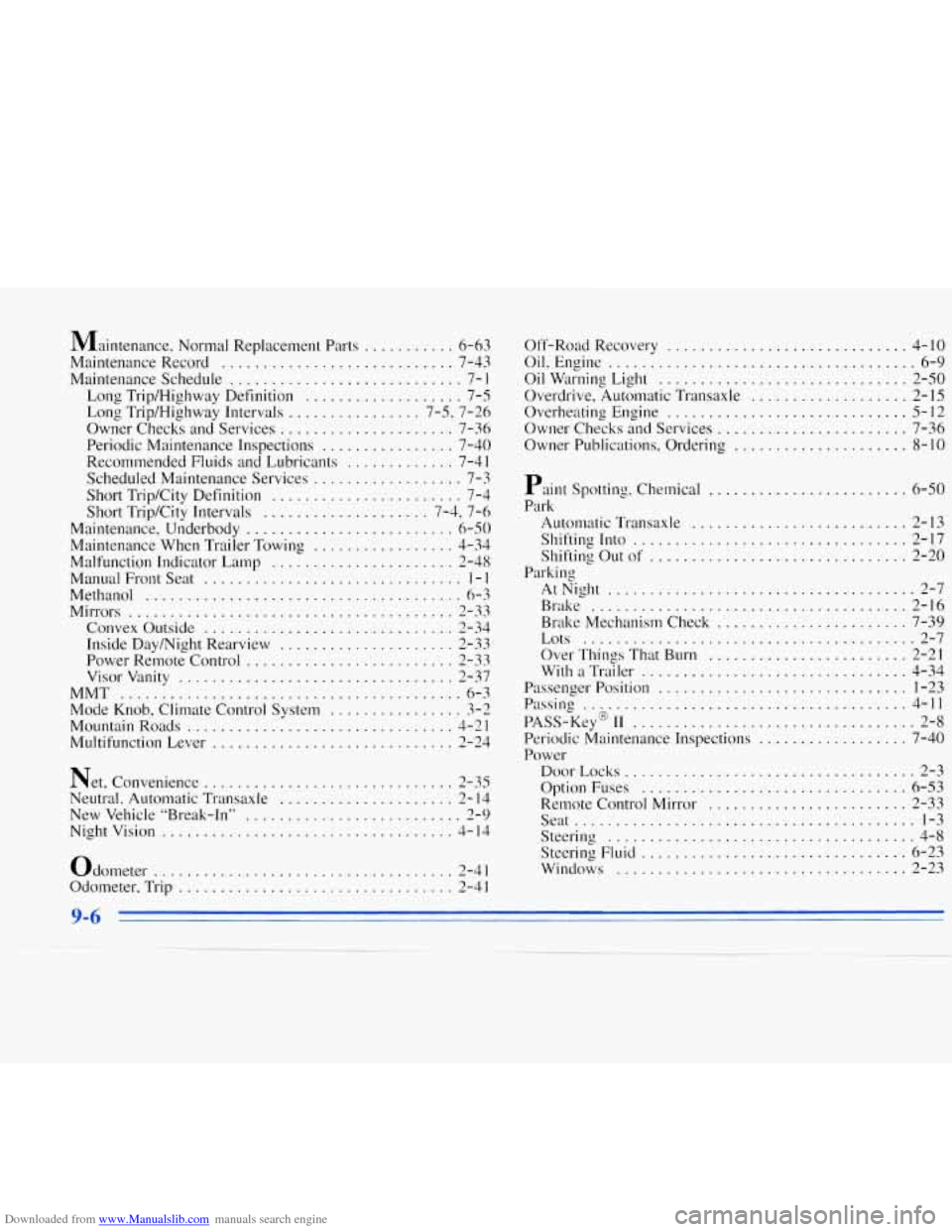
Downloaded from www.Manualslib.com manuals search engine Maintenance. Normal Replacement Parts ........... 6-63
Maintenance Record
............................ 7-43
Maintenance Schedule
............................ 7-1
Long TripIHighway Definition
................... 7-5
Long Trip/Highway Intervals
................ 7.5. 7-26
Owner Checks and Services
..................... 7-36
Periodic Maintenance Inspections
................ 7-40
Recommended Fluids and Lubricants
............. 7-4 I
Scheduled Maintenance Services .................. 7-3
Short Trip/City Definition
....................... 7-4
Short Trip/City Intervals
.................... 7-4. 7-6
Maintenance. Underbody
......................... 6-50
Maintenance When Trailer Towing
................. 4-34
Malfunction Indicator Lamp
...................... 2-48
Manual Front Seat ............................... 1- 1
Methanol ...................................... 6-3
Mirrors ....................................... 2-33
Convex Outside
.............................. 2-34
Inside Day/Night Rearview
..................... 2-33
Power Remote Control
......................... 2-33
Visor Vanity
................................. 2-37
Mode Knob. Climate Control System
................ 3-2
MountainRoads
................................ 4-21
Multifunction Lever
............................. 2-24
MMT
......................................... 6-3
Net. Convenience
.............................. 2-35
Neutral. Automatic Transaxle
..................... 2- I4
New Vehicle “Break-In”
.......................... 2-9
Nightvision
................................... 4-14
Odometer
.................................... 2-4 1
Odometer. Trip ................................. 2-41 Off-Road
Recovery
............................. 4- IO
Oil. Engine ..................................... 6-9
Oil Warning Light
.............................. 2-50
Overdrive. Automatic Transaxle
................... 2-15
Overheating Engine
............................. 5-12
Owner Checks and Services ....................... 7-36
Owner Publications. Ordering
..................... 8-10
Paint Spotting. Chemical ........................ 6-50
Park
Automatic Transaxle .......................... 2-13
Shifting Into
................................. 2-17
Shifting
Out of ............................... 2-20
Parking
AtNight
..................................... 2-7
Brake
...................................... 2-16
Brake Mechanism Check
....................... 7-39
Lots ........................................ 2-7
Over Things That Burn
........................ 2-21
With
a Trailer ................................ 4-34
Passenger Position
.............................. 1-23
Passing
....................................... 4-11
PASS-Key I1 2-8
Periodic Maintenance Inspections
.................. 7-40
Power DoorLocks
................................... 2-3
Remote Control Mirror
........................ 2-33
Seat
......................................... 1-3
Steering ..................................... 4-8
Windows
................................... 2-23
8 ..................................
Option Fuses ................................ 6-53
Steering
Fluid ................................ 6-23
Page 337 of 340
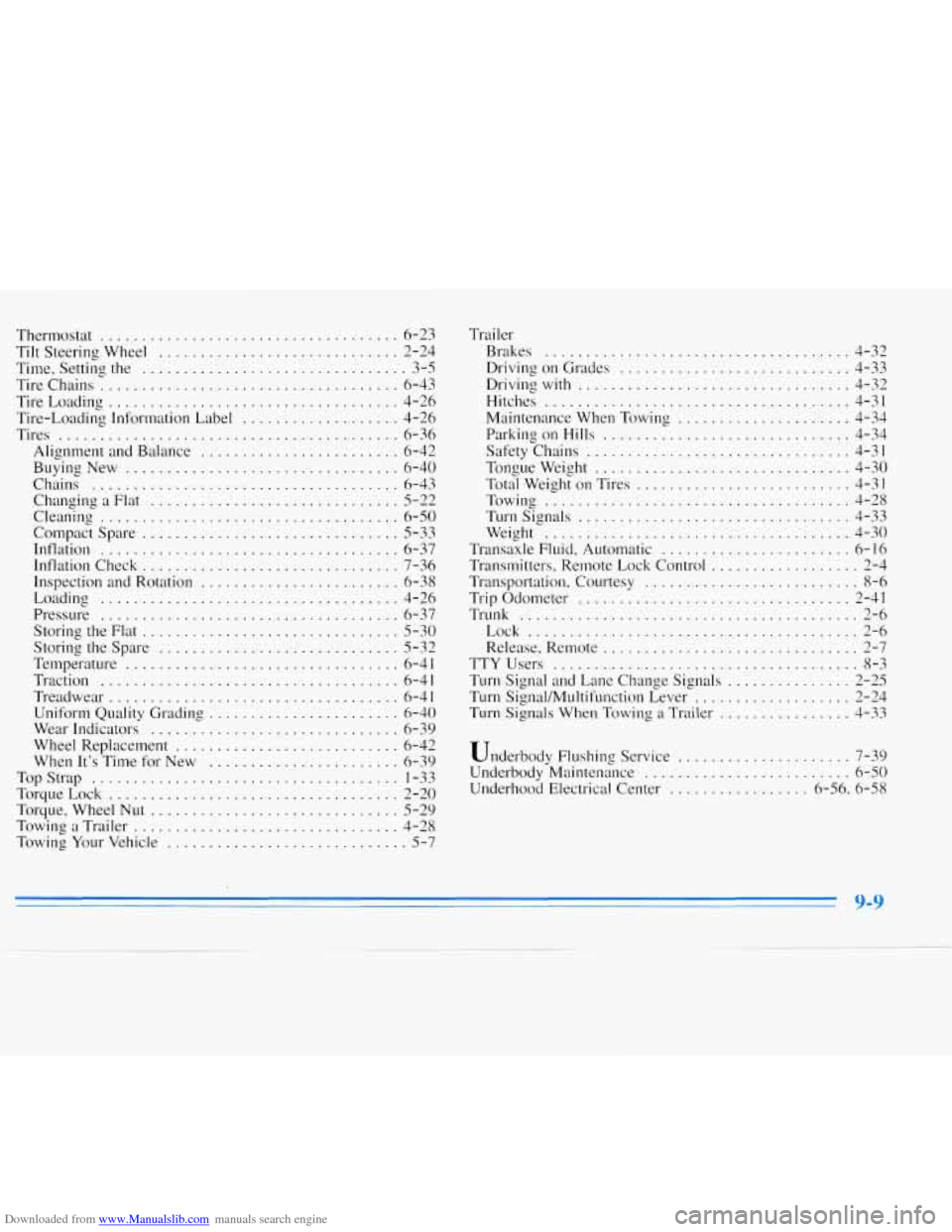
Downloaded from www.Manualslib.com manuals search engine Thermostat .................................... 6-23
Tilt Steering Wheel
............................. 2-24
Time. Setting the
................................ 3-5
TireLoading
................................... 4-26
Tire-Loading Information Label
................... 4-26
BuyingNew
................................. 6-40
Tire Chains
.................................... 6-43
Tires
......................................... 6-36
Alignment
and Balance ........................ 6-42
Chains
..................................... 6-43
Changing a Flat
.............................. 5-22
Cleaning
.................................... 6-50
Compact Spare
............................... 5-33
Inflation
.................................... 6-37
Inflation Check
............................... 7-36
Inspection and Rotation
........................ 6-38
Loading
.................................... 4-26
Pressure
.................................... 6-37
Storing the Flat
............................... 5-30
Storing the Spare
............................. 5-32
Temperature
................................. 6-4 I
Traction .................................... 6-41
Treadwear
................................... 6-41
Uniform Quality Grading
....................... 6-40
Wear Indicators
.............................. 6-39
Wheel Replacement
........................... 6-42
When It’s Time for New
....................... 6-39
TopStrap
..................................... 1-33
TorqueLock
................................... 2-20
Torque, Wheel
Nut .............................. 5-29
TowingaTrailer
................................ 4-28
Towing Your Vehicle
............................. 5-7 Trailer
Brakes
Driving
Driving
Hitches
..................................... 4-32
onGrades
............................ 4-33
with ................................. 4-32
..................................... 4-31
Maintenance When Towing
..................... 4-34
Parking on Hills
.............................. 4-34
Safety Chains
................................ 4-31
Tongueweight
............................... 4-30
Total Weight on Tires
.......................... 4-31
Towing
..................................... 4-28
TurnSignals
................................. 4-33
Weight
..................................... 4-30
Transaxle Fluid. Automatic
....................... 6-16
Transmitters. Remote Lock Control
.................. 2-4
Transportation. Courtesy
.......................... 8-6
Trip Odometer
................................. 2-41
Trunk
......................................... 2-6
Lock
........................................ 2-6
Release. Remote
............................... 2-7
TTYUsers ..................................... 8-3
Turn Signal and Lane Change Signals
............... 2-25
Turn Signal/Multifunction Lever
................... 2-24
Turn Signals When Towing
a Trailer ................ 4-33
Underbody Flushin, o Service ..................... 7-39
Underhood Electrical Center
................. 6-56. 6-58
Underbody Maintenance
......................... 6-50
9-9